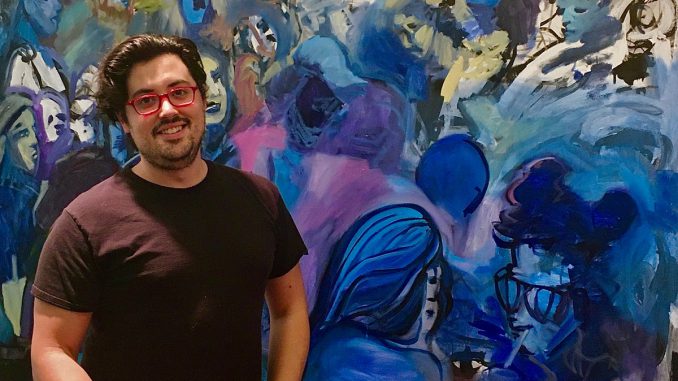
The studio is riddled with old and new paintings, sketches, tubes of oil paint, palettes, brushes and jars of thinner. If you’ve ever seen an artist’s workspace, this is it. Pinned along the walls are pencil, ink, and watercolor sketches of bars, nightclubs, and other leisure spaces. These drawings work as studies for MFA student Mike Serafino’s latest series of paintings which looks to nightlife and public leisure activities, tying together a rich art historical tradition in present day settings. Using rich colors and painterly forms, Serafino endows these already lively spaces with a heightened sense of energy and narrative.
These locations may be familiar, especially if you happen to be part of the gallivanting crowds, strutting around the Bushwick and Williamsburg area on any given night. For example, a large unstretched canvas hanging on the wall of his studio captures a rather calm night at Rebecca’s in Bushwick. This piece, though unfinished, depicts the bar’s patrons mingling and sitting quietly in the darkly lit and moody atmosphere in oil paint. With dark sanguineous walls and washes of dark blues and black which make up the floor, the scene’s intimate mood emanates from a glow of pink and orange lamps which float in like orbs.
Serafino’s usage of color is paramount to his conveyance of mood, and the artist’s perspective as observer is seen most clearly here, as he is seated not at the bar with said patrons, but behind them, as if catching them in their acts.
“I’d describe it as sitting quietly in crowded places,” says Serafino.
Another large-scale, and unfinished, work on canvas depicts a wild burlesque night at the House of Yes, a famous nightclub which often plays host to burlesque and drag performers. Similar to the previous work, the viewer is placed outside of the action, we are observing, though much closer to the action. This piece in particular seems to harken back to the work of Henri de Toulouse-Lautrec, the French nineteenth century painter who often sought to capture the rambunctious dance-filled nights of the Moulin Rouge.
But Serafino doesn’t have to look too far back for inspiration, he cites Nicole Eisenman, Dana Schutz, and Cecily Brown as major influences as well. These artists also work in, more or less, a style which is predominantly figurative and, like Serafino, use color as the major delineator of form. Also permeating through his work is a narrative structure which he sees as reflected especially in the forms.
While the “Social Scenes,” certainly depict a rowdy night out, the kind that has been looked at in art for over a century, they also seek to examine certain aspects of our own times; this decadence and debauchery is not without political implications. Many of these club-goers frequent these spaces in order to escape the stratification experienced in the outside world. This, for Serafino, is central.
“Relaxation is important, leisure has a place in history,” says Serafino, who cites the Brooklyn bohemian and queer aesthetic as a major influence, “it’s all kind of justifiably decadent.”
If you’d like to see the studio, as well as the other MFA and BFA students’ work spaces, come to the Art All Day event on November 8th from 12pm-8pm. Hosted by the Brooklyn College Art Department, this event offers students and staff a special look into the campus’ thriving art scene. More information can be found on the Art Department’s website, as well as on fliers posted all around Boylan Hall.
